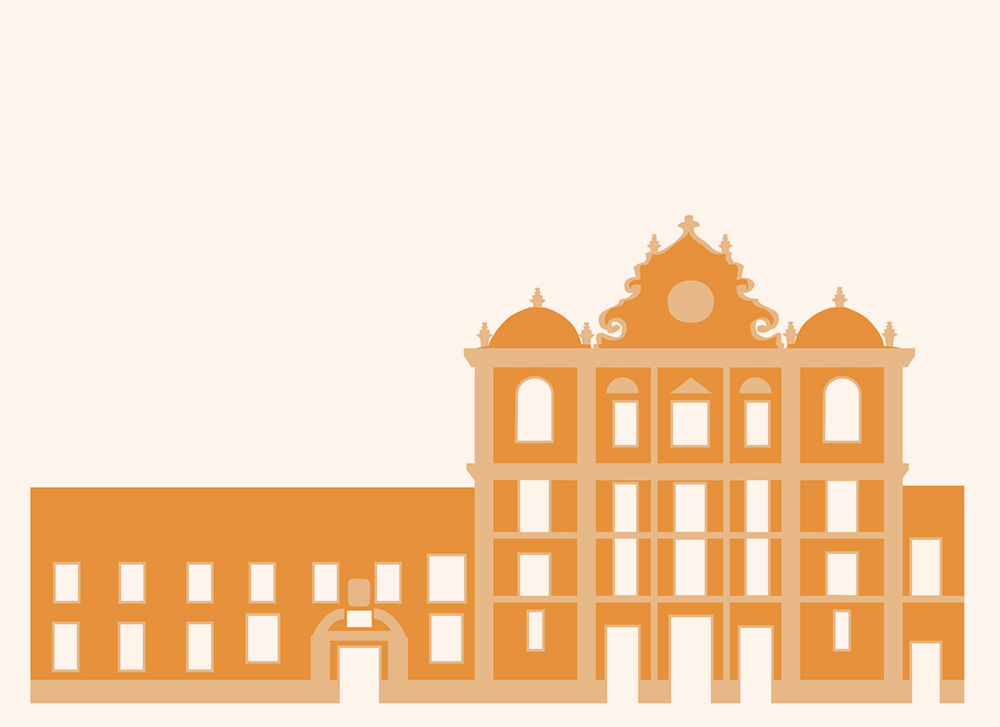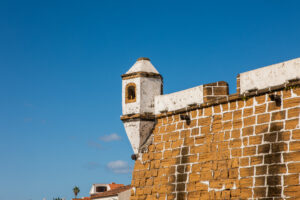
Early Horta – The origins
This itinerary presents the city’s oldest structures, testimonies dating back to Horta’s first centuries from the times of the settlement until the 18th century.
The current urban development of the city had its settlement in two main clusters: in the surroundings of Monte Queimado, nowadays the parish of Angústias, and by the stream Ribeira da Conceição, an area which was given the name of “Vila Velha” (Old Town) by Gaspar Frutuoso, a chronicler who visited the islands in the late 16th century.
Throughout the 16th and 17th centuries, the first religious and defensive fortifications started to emerge, shaping the urban layout of the village.
The buildings were predominantly established from north to south, occupying the area between the two edges of the sheltered bay. This layout resulted in a settlement shaped like an amphitheatre facing the sea.
- Horta
- Average duration of 4 hours
- Some locations are subject to opening hours.
- Low difficulty level
1. Forte de Santa Cruz
This Fort, also known as Castelo de Santa Cruz, was erected in the 16th century. It was built by an Italian engineer on a sand beach with the purpose of protecting the bay from pirate and privateer attacks that passed through the Azores, in pursuit of goods from India and Brazil.
Made with basalt and tuff, only the outer walls and a chapel from the 17th century dedicated to Santo António (Saint Anthony) remain.


2. Igreja das Angústias
3. Forte de São Sebastião
The Fort or Castle, built in tuff in the 17th century, used to be part of the defensive system of Porto Pim, along with the Reduto da Patrulha (the Sea-Gate of Porto Pim). Initially, it was known as Castelo da Cruz dos Mortos and used to monitor the incoming vessels from the southern side of the island, as well as the arrivals and departures from the small cove.
In the beginning of the 18th century, it was rebuilt and used as a prison approximately until the end of World War II.


4. Reduto da patrulha (Patrol Bastion)
Also known as the Sea-Gate of Porto Pim, it was part of the bay’s defensive system, being its access point to the sea.
This structure includes a watchtower and about ten cannons on its terrace.
5. Império dos Nobres
This império (small temple in devotion to the Holy Spirit), also known as Império de Reconhecimento e Beneficência, was built in the mid-18th century. It was erected by Horta’s City Council following a volcanic eruption, which occurred between Praia do Norte and Capelo, in 1672.
With baroque and manueline elements, this would have been the first império built in stone and lime, since the former structures for these celebrations were only temporary.


6. Torre do Relógio (Clock Tower)
This tower was built as part of an ancient church, the first Mother Church of Horta, from the early 16th and demolished in 1825.
For decades, the tower dating from the early 18th century featured a clock purchased in England from that the same century.
Despite the church’s demolition, the tower remained and the space where the church once stood later originated the Largo Dom Luís, locally known as Largo do Relógio.
7. Igreja e Convento do Carmo
This church was erected in the site of an old chapel dedicated to Nossa Senhora da Boa Nova (Our Lady of Good Tidings), dating from the mid-17th century. A convent was later added to it to house the Carmelite friars, who frequently passed through Faial on their journeys to and from Brazil.
The construction of the current church began in 1698. The main building was completed in 1751 and the façade in 1797.
The outcome was a church with an imposing Baroque-inspired façade, standing out by its magnanimous height and privileged location. We emphasize the baroque style altarpiece and side altars in gilded woodcarving, as well as the tile panels.
After the earthquake of 1926, the former convent was mainly replaced by other structures, later accommodating a military barrack.


8. Antigo Colégio dos Jesuítas (Former Jesuit College)
It is one of the three institutions of the Companhia de Jesus nos Açores (Society of Jesus in Azores) and is considered to be the most remarkable and imposing building in Horta.
The construction of the church dates to the late 17th century, while the adjacent buildings began being built in the year of 1719. This church, initially known as Igreja do Colégio and dedicated to Nossa Senhora dos Prazeres, became the Igreja Matriz do Santíssimo Salvador, in 1825.
The magnificence of its façade, as well as the gilded woodcarvings and the stunning tile panels of the Baroque period stand out, embellishing its interior. On the left side of the church there is a fascinating entrance decorated with basalt stonework, which would be the entrance to the former school.
Over time and even today, the building hosted the main administrative services of the town (Judicial Court, Municipal Library, Division of Finance, among others). Currently, the City Council of Horta is located in the north building, and the Museum of Horta in the south building.
9. Igreja de São Francisco
The church had its origin in a primitive convent of the Franciscan Order, which was probably founded in the early 16th century and originally located closer to the sea. However, in 1597 it was looted and burned during an attack by English privateers, and later destroyed again by the sea in 1669. The convent was therefore moved to its current location in the late 17th century.
This church, dedicated to Nossa Senhora do Rosário (Our Lady of the Rosary), has a bell tower on its left side, and consists of three naves in its interior. Here stand out the altarpieces in gilded woodcarvings, the exotic woods, the paintings on canvas and the tile panels from the 18th century.





